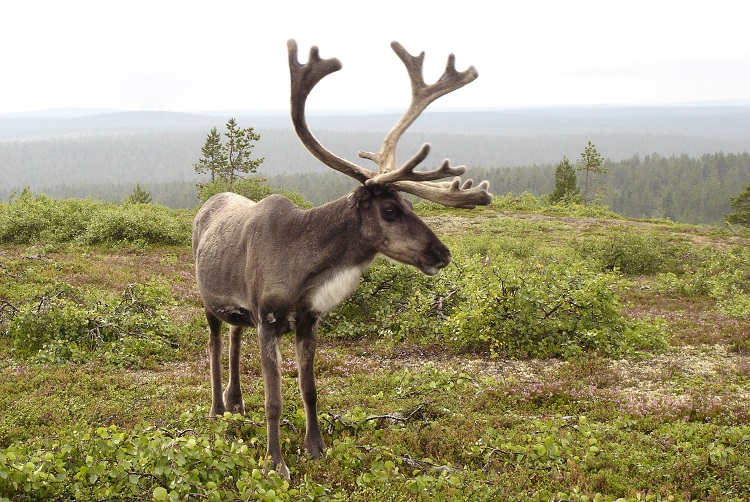Reindeer have had a long history with mankind. Dwelling in the boreal forests and tundra of the Arctic, these impressive animals have adapted to thrive in extreme cold. They are associated with Christmas legends and have pulled sleighs for nomadic peoples for thousands of years.
They are very docile and trusting animals that live together in large groups and migrate huge distances to find food. Their amazing antlers are one of their most prominent features, but their bodies also have unique biological superpowers that help them survive bleak winters.
Are you ready to discover more incredible facts about these majestic snow-dwelling creatures? Read on to find out all you ever wished to know about Reindeer!
Reindeer Natural History
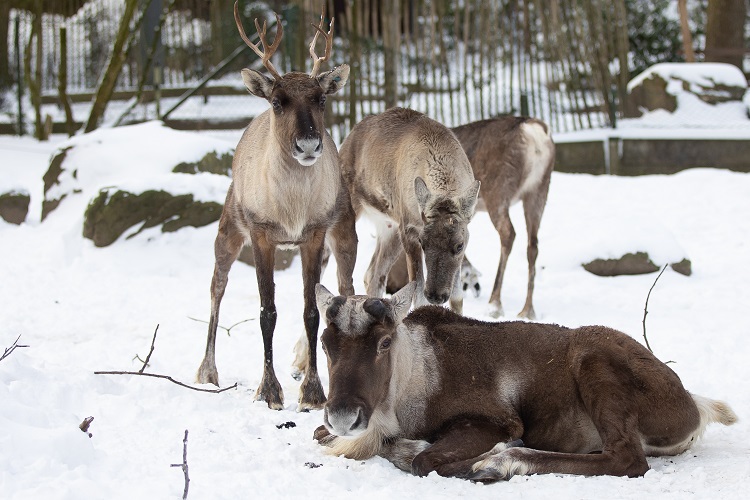
The very first deer are believed to have first appeared about 20 million years ago. However, the oldest fossil of a reindeer has been dated 400,000 years old. This is around the time that the last known ice age began, so Reindeer have been on Earth for quite a long time!
Reindeer have also been in contact with and had a relationship with people for thousands of years. Archaeological records show that 2000 years ago, some Siberian tribes were riding reindeer as a means of transportation.
Nowadays, these people still use reindeer to pull sleds, just like Santa’s sleigh!
Reindeer Evolution
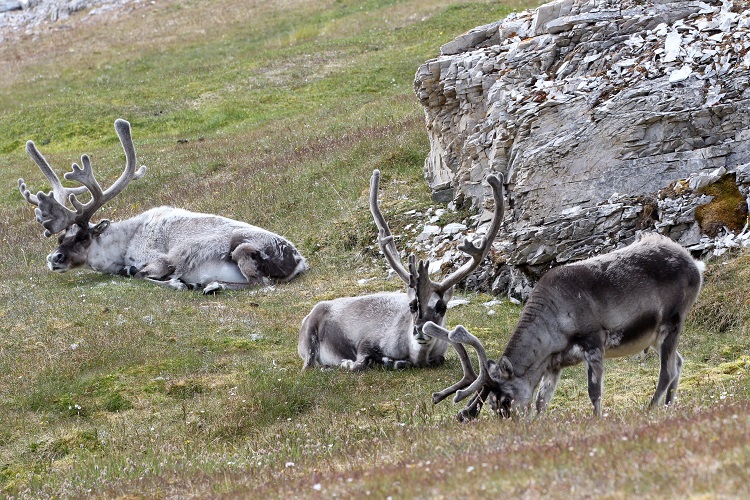
Reindeer are believed to have evolved as a distinct species 1 million years ago. Out of the subfamily of deer, they are the most recent species to have emerged. This means they haven’t changed much over all this time.
They are incredibly well adapted to the extreme cold climates that they live in. In some areas above the Arctic circle, reindeer need to be tough enough to endure temperatures as low as -67 degrees celsius!
During winter, there’s almost no daylight for months on end, so this amazing deer must be very resilient to survive.
Researchers believe that reindeer have special genes that give them traits other mammals don’t have. It’s almost like reindeer have superpowers!
For example, they are much more efficient at using vitamin D than other animals. Vitamin D is created by our bodies when the skin is exposed to sunlight. However, reindeer live in environments that are almost completely dark for months on end. So how do they manage?
Well, this clever deer has a unique gene mutation that regulates their use of the sunshine vitamin so their bodies don’t run out of it during the dark months.
In fact, reindeer are up to 20 times more efficient at using vitamin D than any other mammal. This is especially important because they need to use vitamin D to create their bony antlers!
Aside from being excellent at conserving vitamins, reindeer are also great at regulating their biological clocks.
Our “biological clock” or “circadian rhythm” is a timing system that is determined by sunrise, sunset, and the hours of daylight. Almost all animals and plants have a biological clock. It is made up of certain proteins that interact with cells on a particular schedule according to the time of day.
This clever animal is able to adjust their biological clock so that they can continue to feel alert, stay healthy and maintain body functions when daylight disappears. If they did not have this ability, they would feel groggy and sleepy all the time during the winter. Pretty cool, right?
Species and Subspecies of Rangifer tarandus
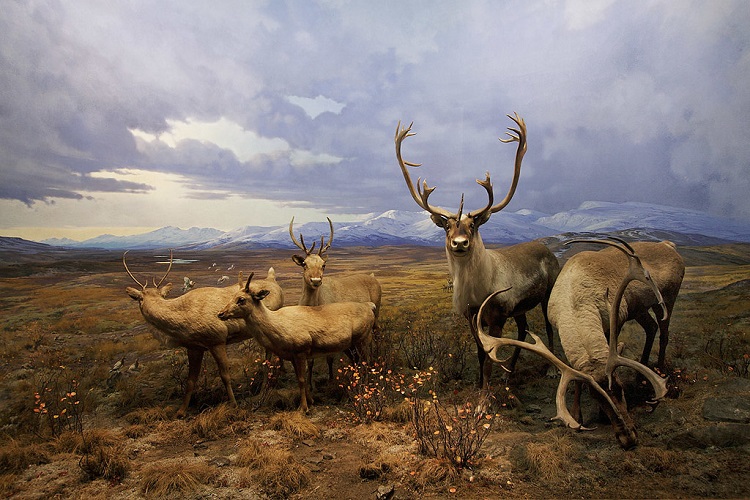
You may have heard the name Reindeer and Caribou used interchangeably. This is because they are the same animal in the deer family.
In North America, wild individuals are called Caribou. If they are domesticated, they are called Reindeer. In Europe, they are called Reindeer, whether wild or domesticated.
The scientific name for Reindeer is “Rangifer Tarandus”. They are a member of the deer family, which is called Cervidae. But there are also 2 main subspecies of Reindeer.
The two main Rangifer species are:
Rangifer Tarandus Tarandus– also known as the Eurasian Tundra Reindeer.
Rangifer Tarandus Fennicus – commonly known as Eurasian Forest Reindeer.
As is clear from their names, one subspecies is found mostly in the tundra regions of the northwest territories of Scandinavia and Russia, while the other is found in the taiga regions of Russian forests.
However, in the northern Arctic, there are also two island subspecies called “Peary Caribou” (Rangifer Tarandus Pearyi) and “Svalbard Reindeer” (Rangifer Tarandus Platyrhynchus).
The Peary Caribou only lives in the Queen Elizabeth Islands of Canada. The Rangifer Tarandus Platyrhynchus is the smallest subspecies and lives in the Norwegian Svalbard archipelago.
Habitat and Distribution
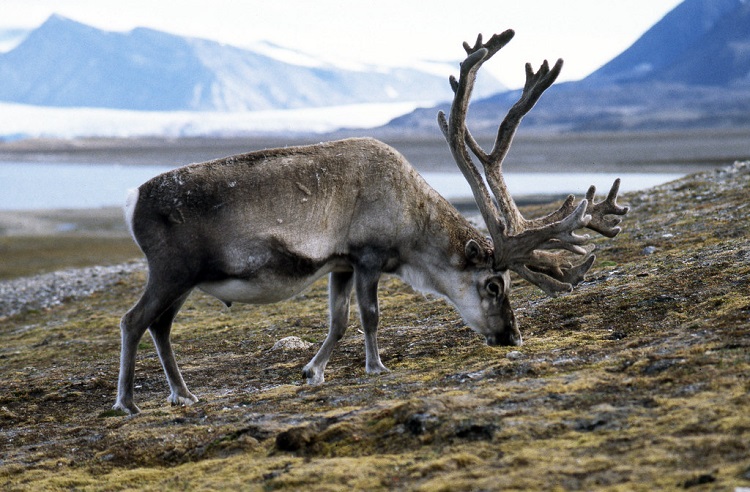
Most reindeer live in Eastern Europe, Greenland, Russia, Scandinavia, Mongolia, northern China, Canada, and Alaska.
During the 19th century, this animal was present in southern Idaho in the United States and they also lived in Ireland. Reindeer were roaming wild in Scotland until the 12th century when they were wiped out by hunting.
During the later stages of the Pleistocene Epoch, reindeer were also present in different regions. They were found in the southern United States of Tennessee, Alabama, and Nevada, as well as Spain. But unfortunately, they have vanished from these regions due to climate changes.
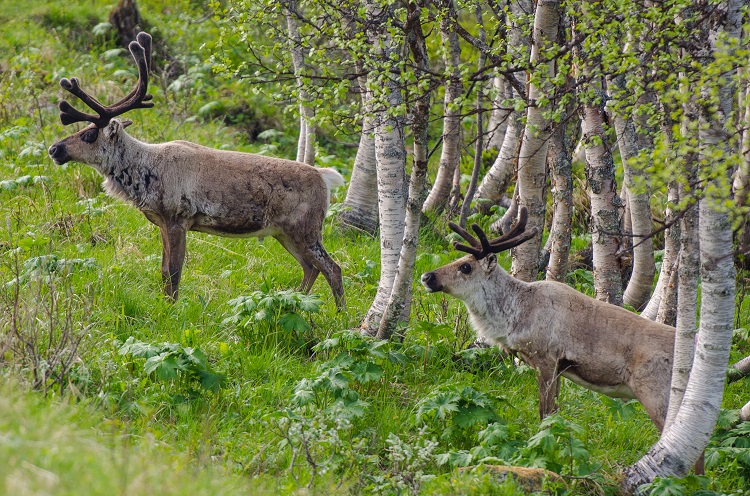
You can still find large wild reindeer populations in Greenland, Alaska, Canada, Siberia, Norway, and Finland, where the habitat and climate are best suited to them.
Reindeer habitat is “tundra” and “taiga”, which are found in very cold climates like Alaska. Tundra has no trees at all, just scrub, while taiga describes icy forest regions.
Physical Features of the Reindeer
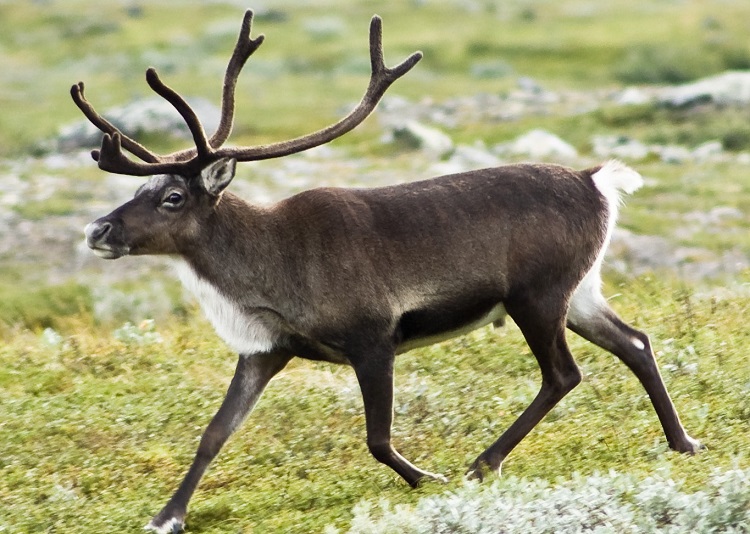
Reindeer are the second largest deer species. The Moose being the biggest.
Male Reindeer stand between 100-130 cm tall at the shoulder and can weigh up to 220 kg. Females are a little smaller. They can reach 95-115 cm tall and weigh less, with a maximum of around 150 kg. Interestingly, domesticated Reindeer are often 20-40% smaller than their wild cousins.
Reindeer have a solid, gray/brown coat with a lighter gray color on their belly. They are darker on the legs and flanks. They have short tails, white rumps, and feet. Only the males have a white mane.
In the summer months, their coat is dark brown, while in the winter months, it becomes lighter. This helps them to blend in with their surroundings. Their winter coat has dense underfur and thick hollow hairs on the outside to keep them cozy and warm.
Reindeer have very wide hooves which spread out their weight. This stops them from sinking into snow or boggy ground when the ice melts. In the summertime, the foam pads in their feet expand to grip softer surfaces. During winter, they contract so that they can use their hooves to walk on ice. Additionally, the edges of a reindeer’s hooves are sharp enough to cut through ice and snow, aiding in gaining traction in slippery conditions.
Both males and females have furry feet to keep out the bitter cold and allow a better grip on slippery ground.
Antlers are probably the most striking feature of these beautiful animals. Both males and females grow antlers. Compared to their body size, they have the largest antlers of any deer species.
Male antlers can grow to an impressive 130 centimeters long. They’re heavy too, weighing up to 15 kg. Just imagine what carrying all this weight on your head must feel like?!
Female antlers are much smaller and lighter. Their antlers grow to about 50 centimeters, so less than half that of the big males. Each antler has a main stalk or “beam”, which is attached to the skull. It then branches off into smaller pieces, ending in tips which are called “points”.
Both male and female reindeer grow their antlers at the same time of year, but they shed them during different months. Male reindeer shed their antlers in November, and won’t grow them again until Spring. Females keep their antlers all through the winter snow, and then the antlers fall off in May.
As new antlers develop, they are covered in velvet which is made up of blood vessels and fur. Once they are finished, the velvet dries and shrivels up, and the reindeer shred it off by rubbing their antlers on trees and rocks.
Biology and Behaviors
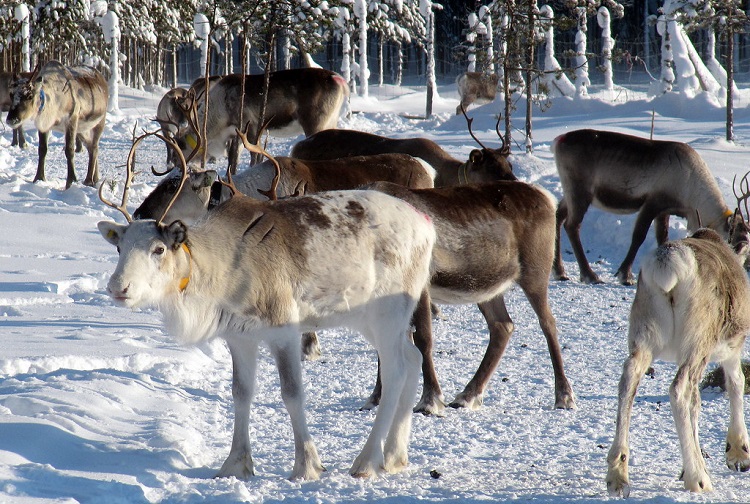
Special adaptions mean reindeer survive their harsh climate and extreme cold. One of the ways they do this is by controlling their body composition to ensure they have enough fat to insulate their bodies.
The body composition of reindeer changes dramatically throughout the year. Between March and September, breeding female Reindeer have a higher body mass compared to non-breeding females. Breeding females can be as much as 10 kg heavier during this time.
However, between November and December, it is the non-breeding females which have a higher body mass. It’s believed that this is because non-breeding females are better able to conserve fat for energy storage before the winter snow, while the mother reindeer have used up more energy during gestation and feeding their young.
Habits and Lifestyle
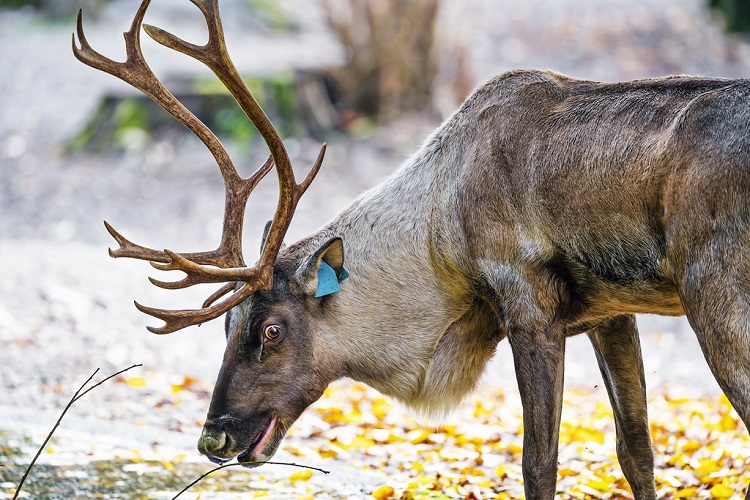
As herding animals, Reindeer are very sociable and love to hang out in a big crowd. They also migrate large distances to find food in tough winter conditions.
Some North American and Alaska Reindeer that live in barren areas migrate 5,000 km every year. This makes them the farthest-traveling terrestrial mammal in the world!
Other populations that live in more food-dense areas may stay in one place all year around. Migratory habits really depend on how pressured the herd feels to find food to survive.
European reindeer populations often have shorter migrations. Those that live on islands such as Svalbard in Norway, will usually make shorter journeys around the island in search of food.
Unfortunately, many migrating reindeer can get sick from parasites, which causes them to become weak and struggle to make the journey.
While migrating, reindeer move quite quickly. They can cover up to 34 miles a day, and they’re capable of running 50 miles per hour when needed. Reindeer calves are speedy too! They can run faster than an Olympic sprinter when they are just 1 day old – so never challenge a reindeer to a race!
Sometimes, a migrating herd will need to cross rivers. They are very good swimmers, capable of swimming at around 4 mph. They are not scared of water and will happily travel across wide rivers or lakes to reach their destination.
During the springtime, small migrating groups all gather together to create a bigger group. These groups can consist of huge numbers, sometimes reaching up to 500,000 individuals. For Autumn migrations, the numbers are often smaller, as many individuals have started to mate.
In winter, reindeer herds survive by moving to more forested areas where they can forage for food beneath the snow. When spring comes, they move away from their winter feeding spots and go to their mating season grounds to get ready for babies.
Reindeer Reproduction
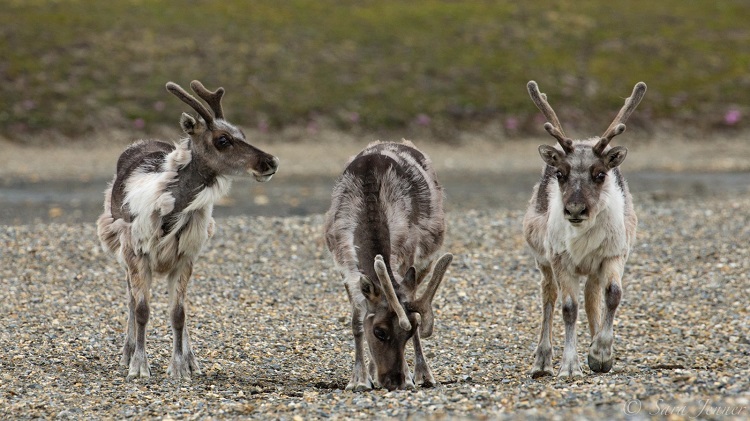
Male reindeer begin to rut during the mating season in September and October. They viciously clash their antlers together to win access to a mate.
The victor will try to keep all his females together in a separate herd, known as a “harem”. Sometimes, other males will try to steal them away, so he may have to keep fighting until the mating season is over.
However, he doesn’t always get his way. The females often stay in the harem until they come into season, at which point they may decide they don’t like their “owner” so much. Sometimes, they visit other males outside of the herd and mate with them instead!
Once pregnant, the females will gestate for about 7 months, giving birth to calves in May and early summer. They usually have just one baby, but they will occasionally have twins.
The calves are born with extra fat around their kidneys, heart, shoulders, and groin to keep them warm in the cold weather. Most of the time, the baby reindeer will be up on its feet and moving around with its mother a couple of hours after it’s born. By the next day, the mother and calf will usually join the rest of the herd.
For the first month, calves will feed on their mother’s milk before transitioning to solid food. Mother milk is the most nutritious of any deer milk. It’s packed with fats, minerals, proteins, and carbohydrates so that the calf can grow quickly.
The baby will stay with the mother during the first winter but will be completely independent by autumn.
Reindeer Diet and Nutrition
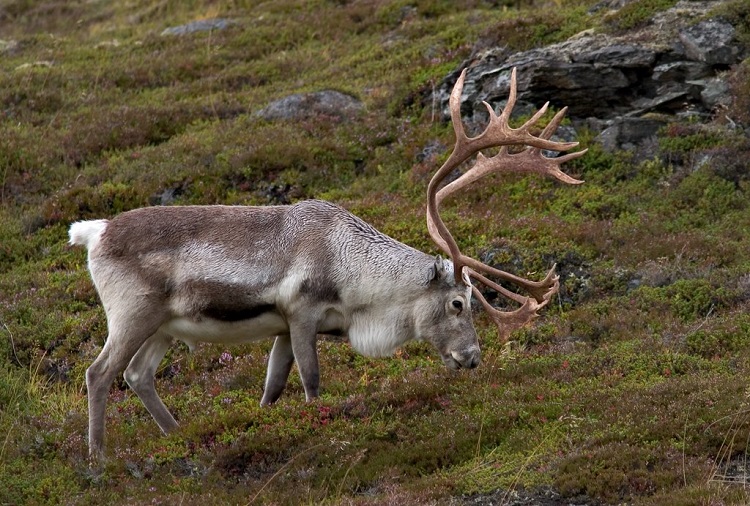
Reindeer are “ruminants”, which means they have a stomach with four chambers.
Reindeer eat lichens (sometimes called reindeer moss) in the winter months. During this time, it is readily available, where other forms of food are scarce. By feeding on this, they don’t need to use much of their fat stores to survive.
Interestingly, they are the only mammal to have a special enzyme called “lichenase”, which allows them to break down and metabolize lichen into energy.
Aside from reindeer moss, they will also eat grasses, mushrooms, and willow and birch leaves. Sometimes, if they are desperately hungry, they will eat the velvet off of other reindeer antlers, small rodents, fish, and bird eggs!
In the Arctic summer, there is continuous daylight. During this time, reindeer actually adapt their sleeping pattern so that they only sleep when they need to digest food. This means they can consume as much as possible while food is plentiful.
Non-pregnant female reindeer tend to eat more moss than pregnant females. It’s believed this is because reindeer moss doesn’t have much nutritional value to support a growing calf.
Reindeer Lifespan
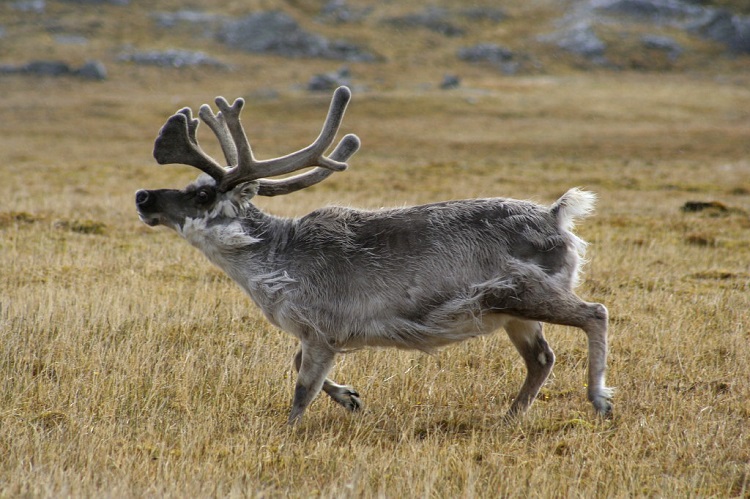
Female reindeer tend to live longer than males. They can reach a lifespan of 17 years if the habitat is good, while male reindeer rarely live beyond 14 years.
The oldest reindeer on record lived for an amazing 22 years!
Reindeer have quite a long lifespan as they have few predators. In North America, packs of Gray Wolves can take down adult reindeer and often kill calves. Golden Eagles, Bears, and Wolverines may also prey on reindeer or their young.
Reindeer Conservation Status
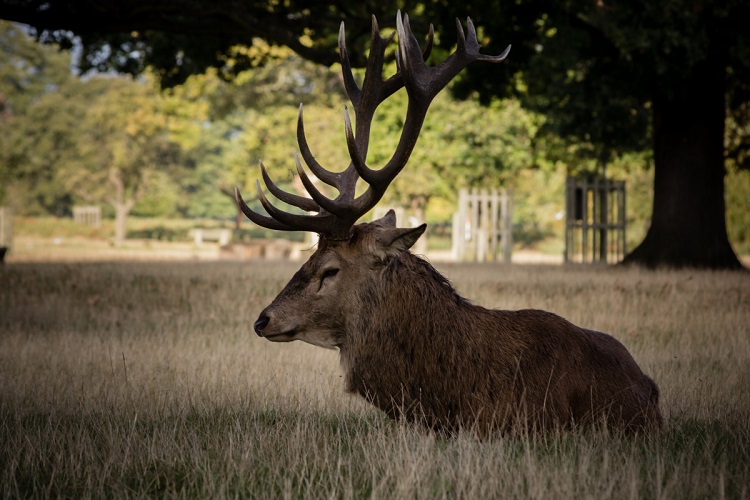
Reindeer are currently listed as a vulnerable species by the International Union for Conservation of Nature (IUCN).
The IUCN has a Red List of threatened species. Reindeer have been moved to the vulnerable category due to a 40% population decline over the past 2-3 decades.
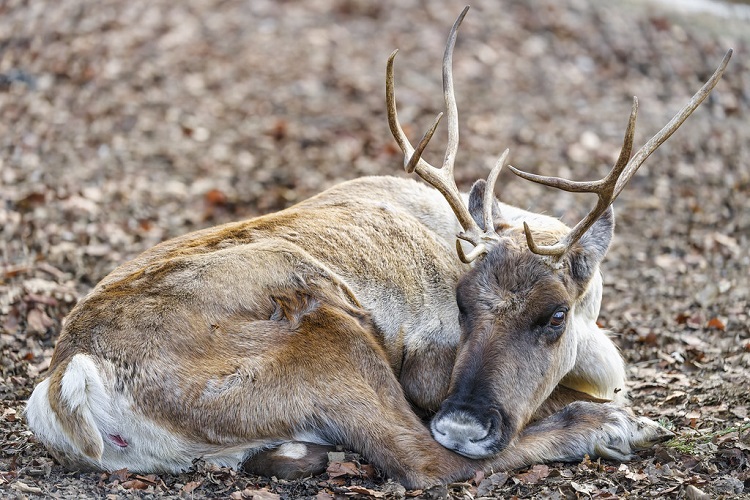
What’s the Difference Between Reindeer and Elk?
Reindeer originated from the Arctic and Subarctic region, while Elk are usually found in North America and in Eastern Asia. Elk are also thicker-set, heavier, and larger than reindeer. They have a large rump and a coat that is reddish in color.
In contrast, reindeer are typically smaller, slimmer, and have a brown-colored coat.
What Is the Difference Between a Deer and a Reindeer?
A reindeer is a type of deer. All deer are ruminants and the males have seasonal antlers. Both male and female reindeer have seasonal antlers, and they live only in specific regions that have cold climates.
What Biological Kingdom Do Reindeer Belong To?
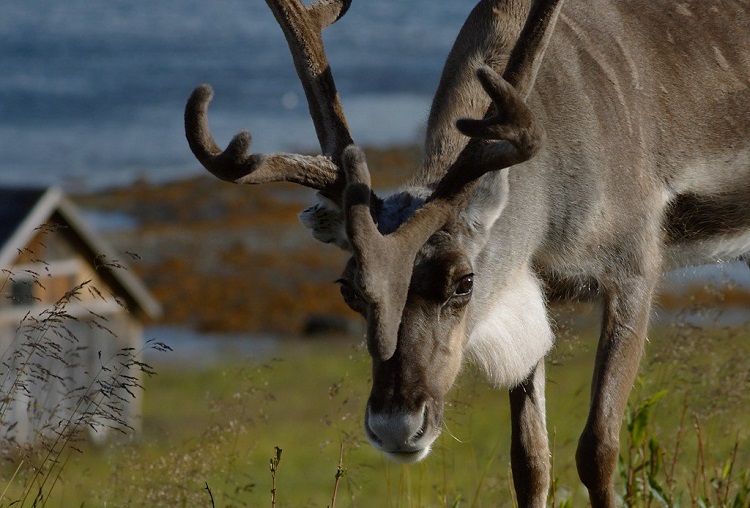
Reindeer belong to the biological kingdom “Animalia”. This kingdom comprises species that are multicellular, eukaryotic organisms that consume organic material, breathe oxygen, reproduce sexually, move around and go through a particular stage of embryonic development.
What Body Covering Does a Reindeer Have?
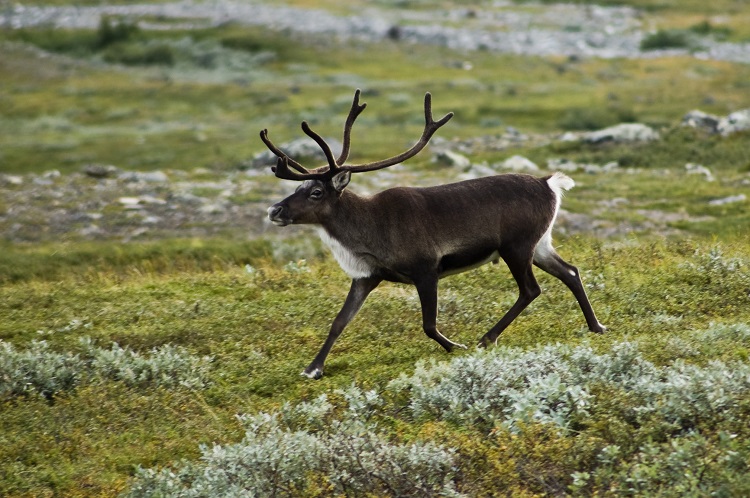
Reindeer are completely covered in hair from the tip of their nose to the bottom of their hooves. The hairy feet look quite unusual, but they are designed to give them a better grip when walking on slippery or icy ground.
They are the only type of deer that have hair all over their nose. This warms up the incoming cold air as they breathe it in, so it isn’t so cold when it reaches their lungs. Reindeer also have an excellent sense of smell to allow them to find food in the snowfall.
The rest of their body is covered with dense fur and a thick undercoat that keeps them insulated from the freezing conditions where they live.
Reindeer Population
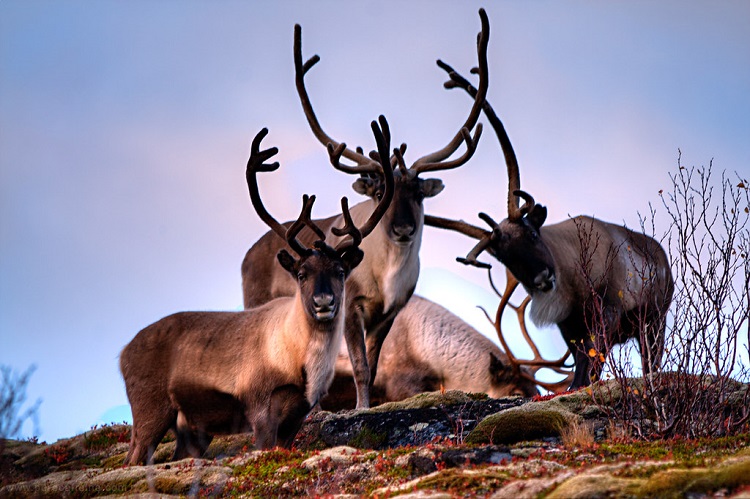
The population of Reindeer is spread out across their range. They are found throughout the Northern Hemisphere, however, their population is very fragmented, and there is believed to be some intermixing between non-domesticated and domesticated herds.
The IUCN believes that truly wild Reindeer only exist in Finland, Norway, and Russia. There are also some herds present in Greenland and in North America, where they are usually called “Caribou”.
Population Number and Decline
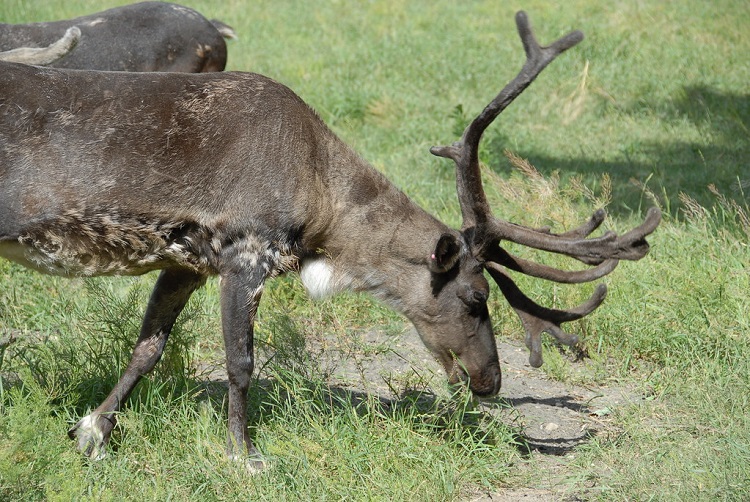
There are currently about 3.5 million Caribou in Northern America including Canada and Alaska, 1 million in Eurasia, and about 3 million tame reindeer in Northern Europe. The global population (which includes domesticated individuals) amounts to around 8 million.
Herd sizes are highly variable. There are large differences between herds in some regions compared to others, as well as size variants in the same location. The largest herd is believed to be in Russia, which contained between 400 thousand and one million reindeer.
While reindeer are widespread in the northern regions, across both tundra and taiga habitats, many herds have seen population decreases in recent years.
Population Threats
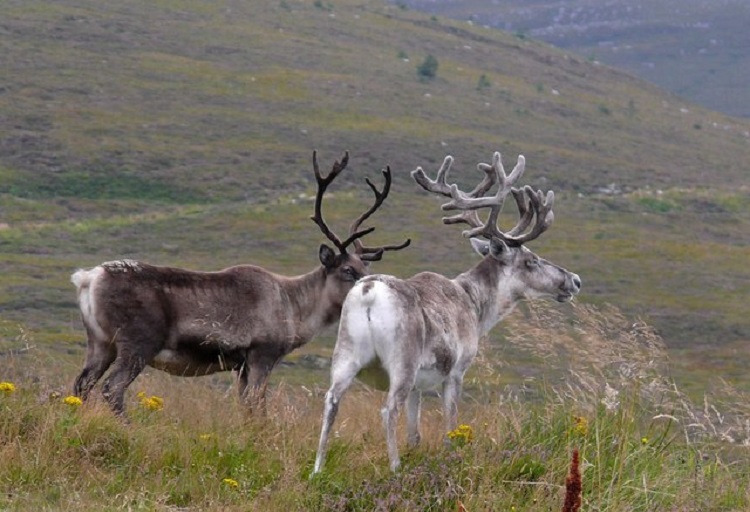
The global decline in the reindeer population is the result of several factors. Climate change has caused disturbances in their natural habitat, which has led to barren grounds and a shortage of food.
On top of this, warmer winters often lead to an increase in rain, which transforms snowy land into an icy surface. The ice prevents reindeer from reaching lichen, which they depend upon in the cold, bleak months.
The situation has become so desperate that there have been reports of these beautiful animals starving to death on the Russian tundra. Between 2006 and 2013, it’s believed 80,000 Reindeer died from starvation.
Climate change isn’t the only threat that reindeer face. Human activity in their habitat is also making it difficult for them to survive. Industrial development, oil exploration, and local communities using snowmobiles have all driven herds away from their usual feeding/breeding grounds.
Reindeer Facts
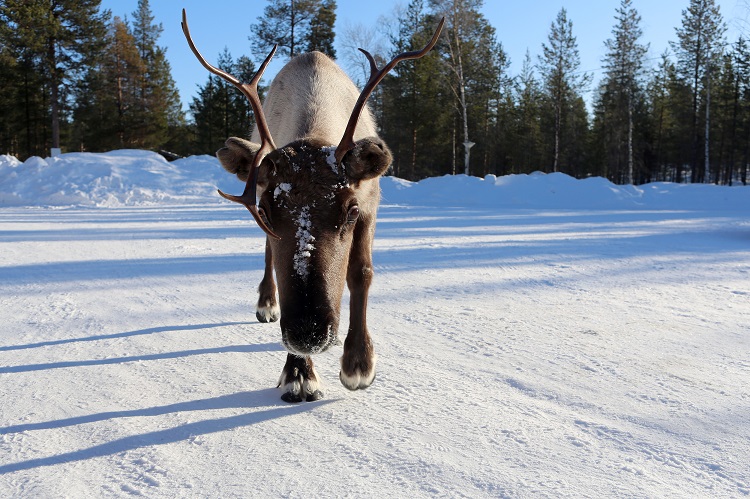
- Reindeer are the only living deer species that have been widely tamed.
- They are the only deer species where the females grow and shed antlers too.
- Male reindeer shed their antlers before females.
- They have lost their innate circadian rhythm to adapt to the Arctic seasons.
- According to legend, they pull Santa Claus’s sleigh through the night sky to deliver presents to children on Christmas Eve.
- Unlike other deer species, they have specialized foot pads that swell or contract according to the season.
Relationship With Humans
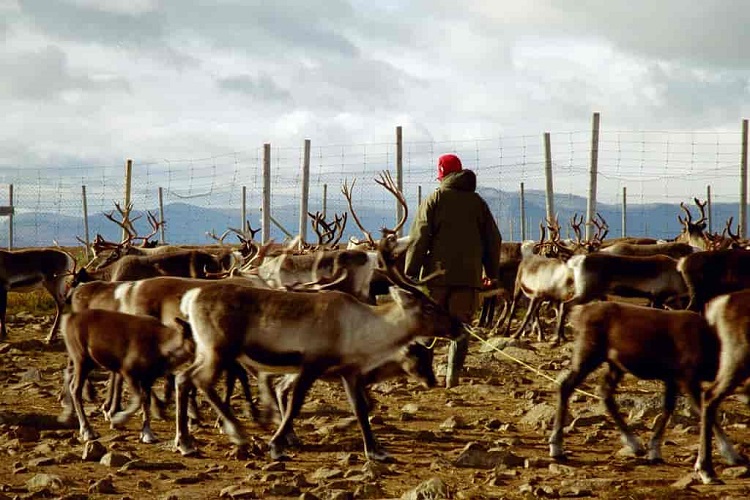
Reindeer have been hunted by humans in many cultures for around 40,000 years. Therefore, it’s quite surprising that they are the most recent animal to be domesticated.
Some people believe that the reason reindeer were not fully tamed sooner is because they had a symbiotic relationship with people. They would live close to human settlements and were quite docile, but they also had a strong independent streak.
Because reindeer have a trusting and relatively calm nature, they are easy to domesticate. They like to be petted and groomed and are happy for people to milk them. They are also good workers and are used to pull sleds in some remote Arctic cultures
Reindeer have been an essential part of life for nomadic people in the Arctic for a long time. The Sami people of Norway, Finland, Sweden, and Russia are believed to have been the first to domesticate reindeer. They still herd them and use them for food, transport, and clothing today.
Conclusion
Reindeer are so much more than Santa’s helpers. With their biological adaptations, they are able to navigate the harshest of environments and find food in bleak winter conditions.
As herd animals, reindeer travel vast distances to find resources. Crossing icy plains and swimming across lakes and rivers to reach their destination. Fur covers their bodies from nose to hoof to keep them cozy and warm, while their feet change shape to help them walk on arctic tundra and snow. How cool is that!
Reindeer and Caribou have a close relationship with humans. Some nomadic people even depend on them to travel across their snowy lands safely. Unfortunately, climate change and human activities have led to a recent reduction in the reindeer population.
Have you been lucky enough to see a wild Caribou or meet Santa Claus Rudolph? Let us know in the comments below!


